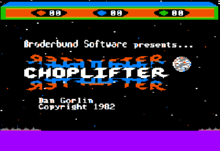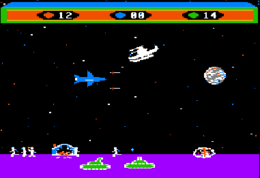Choplifter
Choplifter (stylized as Choplifter!) is military themed scrolling shooter developed by Dan Gorlin for the Apple II and published by Broderbund in 1982. It was ported to Atari 5200, Atari 8-bit family, ColecoVision, Commodore 64, VIC-20, MSX, and Thomson computers. Graphically enhanced versions for the Atari 8-bit family and Atari 7800 were published in 1988 by Atari Corporation.[2]
| Choplifter | |
|---|---|
 Atari 5200 box cover | |
| Developer(s) | Dan Gorlin |
| Publisher(s) | Broderbund Ariolasoft (EU C64) Atari, Inc. (5200) Atari Corp. (7800, 8-bit) Sega (arcade) |
| Platform(s) | Apple II, Arcade, Atari 5200, Atari 7800, Atari 8-bit, ColecoVision, Commodore 64, VIC-20, MSX, Famicom, Master System, Fujitsu FM-7, Thomson MO5, Thomson TO7/70 |
| Release | May 1982[1] |
| Genre(s) | Scrolling shooter |
| Mode(s) | Single-player |
In 1985, Sega released a coin-operated arcade remake, which in turn was ported to the Famicom and Master System in 1986. Choplifter is one of the few games that first appeared on a home system and was ported to the arcade.
Gameplay

In Choplifter, the player assumes the role of a combat helicopter pilot. The player attempts to save hostages being held in prisoner of war camps in territory ruled by the evil Bungeling Empire. The player must collect the hostages and transport them safely to the nearby friendly base, all the while fighting off hostile tanks and other enemy combatants.[3] According to the backstory, the helicopter parts were smuggled into the country described as "mail-sorting equipment."
Although the Iran hostage crisis ended the year before the game was released, Gorlin has stated "the tie-in with current events was something that never really crossed my mind until we published."[4]
The helicopter can face three directions: left, right, or forward (facing the player). It may shoot at enemies in any of these directions and need not fly in the same direction it is facing. The forward-facing mode is used primarily to shoot tanks. The player must be careful to protect the hostages from enemy fire as well as avoid hitting the hostages with his own fire.
The player rescues the prisoners by first shooting one of the hostage buildings to release them, landing to allow the prisoners to board the sortie, and returning them to the player's starting point. Each of the four buildings holds 16 hostages, and 16 passengers can be carried at a time, so several trips must be made. When the chopper is full, no more hostages will attempt to board; they will wave the helicopter off and wait for its return. Usually, each trip back is more risky than the previous one since the enemy is alerted and has deployed a counter-attack.
If the player lands directly on top of a hostage, or completely blocks the building exit, the hostages will be killed. In the Apple II and Atari 7800 versions, hostages will also die if the vehicle is not landed correctly (it is slightly tilted), being crushed as they attempt to board the chopper. While grounded, the helicopter may be attacked by enemy tanks, which it can shoot at only by returning to the air. Also, the enemy scrambles jet fighters which can attack the vehicle in the air with air-to-air missiles or on the ground with bombs.
Development

Coming off a stint working for the Rand Corporation, lead designer Dan Gorlin initially developed Choplifter using an Apple II loaned to him by his grandfather.[5] The game was developed in six months. After Gorlin began experimenting with animating a helicopter on the Apple II, he added scenery, tanks, and planes, with the hostages added last. He stated that, as a story developed, "movie camera techniques seemed appropriate", including the final message "The End" instead of "Game Over". Gorlin's first demonstration to Broderbund was "too realistic, too much a helicopter simulation", and the company helped him make it easier to fly.[6] The concept of rescuing hostages came about after Gorlin learned about Defender, in which the player must protect people on the ground. At first Gorlin imagined Choplifter as a 3D game, but switched to a traditional 2D game environment due to technical limitations. Gorlin would later revisit the 3D concept in a failed attempt to remake the game in the 1990s.[5]
The original Choplifter art for the Brøderbund Commodore 64 release was produced by Marc Ericksen and Gregory Atwood, an art director/illustrator team who created the art for Broderbund's first five covers.
Reception
Softline in 1982 called the game "what may well be the first Interactive Computer-Assisted Animated Movie. A fusion of arcade gaming, simulation, and filmic visual aesthetics, Choplifter is destined to occupy a place in the software Hall of Fame". The magazine praised the animation and the helicopter's "subtle flight control", and concluded that seeing the hostages' "hope and excitement, their faith in you" made the game "hard to play. It hurts to see one of those lively people killed".[6] In 1983 its readers named Choplifter fourth on the magazine's Top Thirty list of Atari 8-bit programs by popularity.[7] BYTE called Choplifter "great fun".[8] Computer Gaming World,[9] Creative Computing Video & Arcade Games,[10] and The Commodore 64 Home Companion[11] praised the graphics and animation, the latter stating that "the little captives running across the desert almost seem alive".
The Apple II version of the game received a Certificate of Merit in the category of "Best Computer Audiovisual Effects" at the 4th annual Arkie Awards,[12]:33 and shortly afterward Billboard named it Computer Game of the Year.[13] The Addison-Wesley Book of Atari Software 1984 gave the game an overall A+ rating, calling it "a masterpiece". The book concluded that "the concept, graphics, and animation make this a delightful game".[14]
Debuting in May 1982, the game sold 9,000 copies by June, appearing on Computer Gaming World's list of top sellers.[1] II Computing listed Choplifter seventh on the magazine's list of top Apple II games as of late 1985, based on sales and market-share data.[15]
Legacy
Choplifter II, subtitled "Rescue Survive," was released for the Game Boy (1991), then remade for both the Game Boy and Game Gear as Choplifter III in 1994. An unrelated Choplifter III was released for Super NES.
Sega released a pair of spiritual successors without the Choplifter brand:
- Air Rescue (1991) for System 32 hardware is a first-person, pseudo-3D take on the concept.
- Air Rescue (1992) for Master System more closely resembles 2D Choplifter, but has stages that scrolled in all directions.
Programmer Will Botti cited Choplifter as a major inspiration for his 1996 game Black Dawn.[16]
inXile Entertainment released Choplifter HD for Xbox Live Arcade, PlayStation Network, and Windows on January 11, 2012, and Ouya in August 2013.
References
- "Inside the Industry" (PDF). Computer Gaming World. September–October 1982. p. 2. Retrieved 2016-03-28.
- "Choplifter!". Atari Mania.
- Mott, Tony (2013). 1001 videos games you must play before you die (Revised and updated ed.). London: Cassell Illustrated. ISBN 9781844037667.
- Hague, James (1997). "Halcyon Days".
- Frank Cifaldi (January 13, 2012). "Choplifter: From 1982 to 2012". Gamasutra. Retrieved June 15, 2018.
- Salmons, Jim (July 1982). "The Choppers of Mercy". Softline. p. 18. Retrieved 17 July 2014.
- "The Most Popular Atari Program Ever". Softline. March 1983. p. 44. Retrieved 28 July 2014.
- Clark, Pamela; Williams, Gregg (December 1982). "The Coinless Arcade - Rediscovered". BYTE. p. 84. Retrieved 19 October 2013.
- Greenlaw, Stanley (July–August 1982), "Choplifter! Rescue the Hostages", Computer Gaming World, pp. 30, 38
- Ahl, David H.; Brill, Andrew; Lubar, David; Coffey, Michael; Archibald, Dale (Spring 1983). "Apple Computer Games". Creative Computing Video & Arcade Games. Vol. 1 no. 1. p. 86.
- "Broderbund Software". The Commodore 64 Home Companion. 1984. pp. 166–167. Retrieved August 19, 2016.
- Kunkel, Bill; Katz, Arnie (March 1983). "Arcade Alley: The Best Computer Games". Video. Reese Communications. 6 (12): 32–33. ISSN 0147-8907.
- Kleiner, Karen (Jul–Aug 1983). "Billboard Conference". Softline. pp. 44–45. Retrieved 28 July 2014.
- Stanton, Jeffrey; Wells, Robert P.; Rochowansky, Sandra; Mellid, Michael, eds. (1984). The Addison-Wesley Book of Atari Software. Addison-Wesley. p. 74. ISBN 0-201-16454-X.
- Ciraolo, Michael (Oct–Nov 1985). "Top Software / A List of Favorites". II Computing. p. 51. Retrieved 28 January 2015.
- "Behind the Screens". Electronic Gaming Monthly. No. 87. Ziff Davis. October 1996. p. 158.
External links
- Choplifter at MobyGames
- Choplifter at the Killer List of Videogames
- Choplifter can be played for free in the browser at the Internet Archive